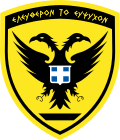Hellenic Army
| Hellenic Army Ελληνικός Στρατός |
|
|---|---|

Hellenic Army Seal
|
|
| Founded | 1821 (de facto) 1828 (official) |
| Country |
|
| Allegiance | Hellenic Republic |
| Type | Land Forces |
| Role | National Defence |
| Size |
standard numbers in peacetime: nominal 90,000 personnel (88,262 as of 2011) (86,150 as of 2013) wartime strength: 253,500 |
| Part of | Hellenic Armed Forces |
| Formations | Formations of the Hellenic Army |
| Patron | Saint George |
| Motto(s) |
Ἐλεύθερον τὸ Εὔψυχον "Freedom Stems from Valour" |
| Colors | Blue-gray, Khaki & Olive |
| Equipment | 1,913 MBTs, 4,209 IFVs & APCs, and 4,840 artillery pieces |
| Engagements |
Greek War of Independence Greco-Turkish War of 1897 Balkan Wars World War I Allied Expedition to Ukraine Greco-Turkish War of 1919–22 World War II Greek Civil War Korean War Turkish Invasion of Cyprus Gulf War War in Afghanistan EUFOR Tchad/RCA War on Terrorism |
| Commanders | |
| Chief of the Army General Staff | Lt. Gen. Alkiviadis Stefanis |
| Notable commanders |
King Constantine I Lt. Gen. Panagiotis Danglis Lt. Gen. Ioannis Metaxas Lt. Gen. Nikolaos Plastiras Lt. Gen. Georgios Kondylis Lt. Gen. Konstantinos Ventiris Fld. Marshal Alexander Papagos Lt. Gen. Thrasyvoulos Tsakalotos (see list of generals) |
| Insignia | |
| Identification marking | ΕΣ |
| Regimental War Flag |  |
The Hellenic Army (Greek: Ελληνικός Στρατός, Ellinikós Stratós, sometimes abbreviated as ΕΣ), formed in 1828, is the land force of Greece (with Hellenic being a synonym for Greek). Along with the Hellenic Air Force (HAF) and the Hellenic Navy (HN), it makes up the Hellenic Armed Forces. It is currently the largest branch of the three. The army is headed by the chief of the Hellenic Army General Staff (HAGS), which in turn is under the command of Hellenic National Defence General Staff (HNDGS).
The motto of the Hellenic Army is Ἐλεύθερον τὸ Εὔψυχον (Eleútheron tò Eúpsychon), "Freedom Stems from Valour", from Thucydides's History of the Peloponnesian War (2.43.4). The Hellenic Army Emblem is the two-headed eagle with a Greek Cross escutcheon in the centre, representing the links between modern Greece, the Greek Orthodox Church, and the Byzantine Empire.
The Hellenic Army is also the main contributor to, and "lead nation" of, the Balkan Battle Group, a combined-arms rapid-response force under the EU Battlegroup structure.
The main missions of the Hellenic Army are the defence of the state’s independence and integrity, the safeguarding of national territory, and the decisive contribution to the achievement of the country’s policy objectives.
During peacetime, the Army has the following main objectives:
The Hellenic Army traces its origin to the regular units established by the Greek provisional government during the Greek War of Independence (1821–1829). The first of these, an infantry regiment and a small artillery battery, were established in April 1822, and were commanded by European Philhellenes. Lack of funds however forced its disbandment soon after, and it was not until July 1824 that regular units were reformed, under the Greek Colonel Panagiotis Rodios. In May 1825, the first law on conscription was passed, and the command of the entire regular forces entrusted to the French Colonel Charles Fabvier. Under Fabvier, the regular corps expanded, and for the first time came to include cavalry, military music detachments, and, with Lord Byron's aid, military hospitals. The governorship of Ioannis Kapodistrias (1828–1831) saw a drastic reorganization of the national military: a Secretariat on Army and Naval Affairs and the Hellenic Army Academy were created, the Army engineering corps was founded (28 July 1829), and a concerted effort was made to reform the various irregular forces into regular light infantry battalions. Throughout these early years, French influence pervaded the Greek regular army, in tactics as well as appearance, as most of the instructors were French–at first Philhellenes, and later serving officers of General Maison's Expeditionary Corps.
...
Wikipedia
